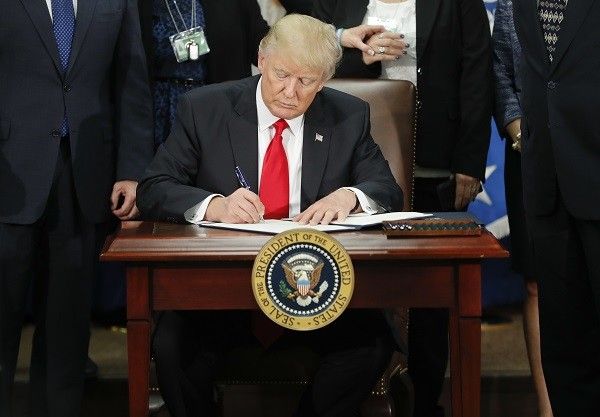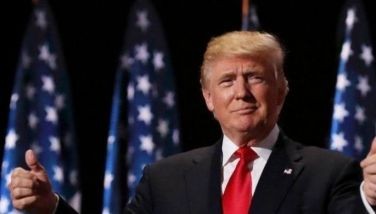How Trump's immigration EO might affect the Philippines

MANILA, Philippines — US President Donald Trump’s executive order on Friday halting the US refugee program for 120 days and preventing immigration from seven Muslim-majority countries has sent shockwaves across the globe, with both leaders and ordinary citizens from several countries expressing consternation and outrage over the order.
The seven Muslim-majority countries affected by the order are Iran, Iraq, Libya, Somalia, Sudan, Syria and Yemen.
Although the Philippines is not included in the list, this ban has taken particular resonance among Filipinos not only because of the scale of immigration to the US from the Philippines but also the pronouncement on Monday of President Rodrigo Duterte that he would not “lift a finger” to help Filipinos in America who would be affected.
This may have caused inadvertent confusion and concern among many in the Philippines. Here’s what the order does and doesn’t do, and how it might affect Filipinos.
According to The Atlantic, an American magazine, the executive order applies only to non-US citizens. However, according to the magazine, the White House said that their Customs and Border Patrol (CBP) would have “discretionary authority” to question US citizens, including Filipinos who have acquired American citizenship, who will be arriving from the seven Muslim-majority countries covered by the ban.
The scope of the prohibition covers refugees waiting for resettlement in the US. In the case of refugees from Syria, they are prevented from entering the US “indefinitely.” Filipinos on any visa category can still enter the US because only citizens from the said Muslim-dominated countries are banned, so far.
Filipino green card holders are also not yet affected since only card holders from these countries traveling overseas are covered although these instances would be considered on a case-to-case basis, The Atlantic reported.
Filipinos holding dual citizenship could still breathe a sigh of relief because the order targets only those from the mentioned countries holding dual citizenship with another country. However, CBP personnel can question people not from the banned countries who hold dual citizenship based on their discretion.
This does not mean that the Philippines will not be affected in the future especially in light of reports indicating that the ban is likely to be extended to other countries and Trump’s statements when he was still campaigning for the US presidency.
During the campaign, then-candidate Trump promised that he would suspend immigration from states with a proven history of terrorism against the US and its allies. In August last year, Trump was criticized by Filipinos and Filipino-Americans after he proposed a ban on immigration from the Philippines which he included in his list of terrorist havens.
The Philippine inclusion in Trump’s list of terrorist havens seems to have a basis especially if the US State Department’s annual report on global terrorist activity is to be believed. In the report, the Philippines, specifically the southern areas of the country, was named as a terrorist activity haven together with Somalia, Mali, Libya, Egypt, Iraq, Lebanon, Indonesia, Malaysia, Afghanistan, Pakistan and Yemen.
If this happens, the Philippines will be significantly affected especially in terms of immigration and overseas Filipinos workers (OFWs) remittances.
According to an analysis by CNN, a total of more than 2.73 million nonimmigrant and immigrant visas were issued by the US State Department to citizens of countries that were either labeled “terrorist safe havens” (the category of the Philippines), “state sponsors of terror,” “nations where terror networks are based and operate” or “countries with active terror cells.”
Of the 2.73 million visas issued, more than 235,000 were issued to the Philippines, the second highest number among those on the list. These people are on top of the 3.5 million Filipino immigrants already living in the US in 2013, according to the Migration Policy Institute.
If Filipinos are barred from entering the US, this will have serious repercussions on the Philippine economy especially on the remittances of our countrymen working abroad. Latest data from the Bangko Sentral ng Pilipinas showed that from January to November 2016, $8.06 billion was remitted by Filipinos in the US, a figure that is 5.3 percent higher than the amount during the same period the previous year. This number might not include money coming from Filipinos who came to the US illegally. They are estimated to be numbering up to 300,000, based on Malacañang speculations.
The number of Filipinos who might not be allowed to enter the US should a policy be enacted and the ban’s impact on the amount of money sent home by Filipinos seriously warrant the government’s attention on this matter. Considering the impact of this on the economy, which is heavily reliant on remittances, as well as on the lives of Filipinos both in the US and in the Philippines, the government should have measures and programs in place to address the possible ramifications of Trump’s executive order. Simply stating that it “won’t lift a finger” is not enough.
- Latest





























